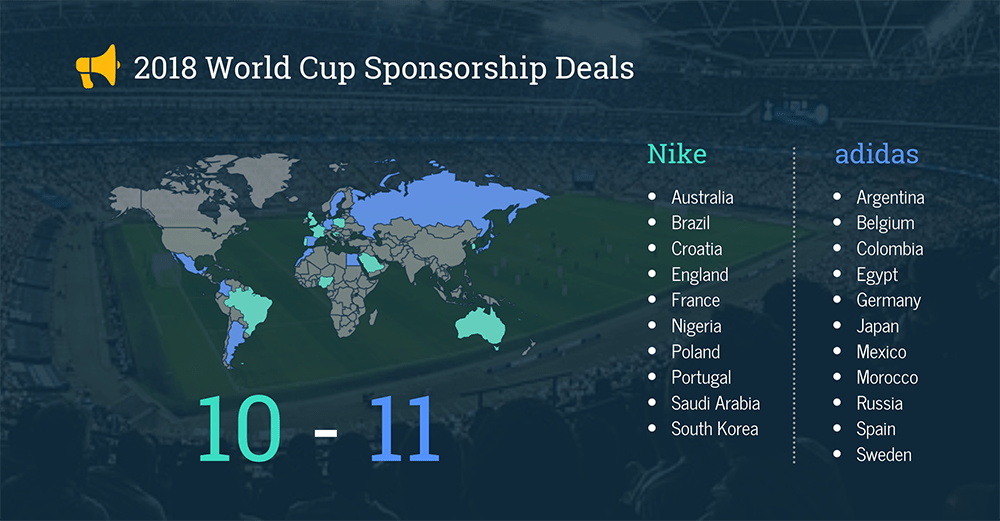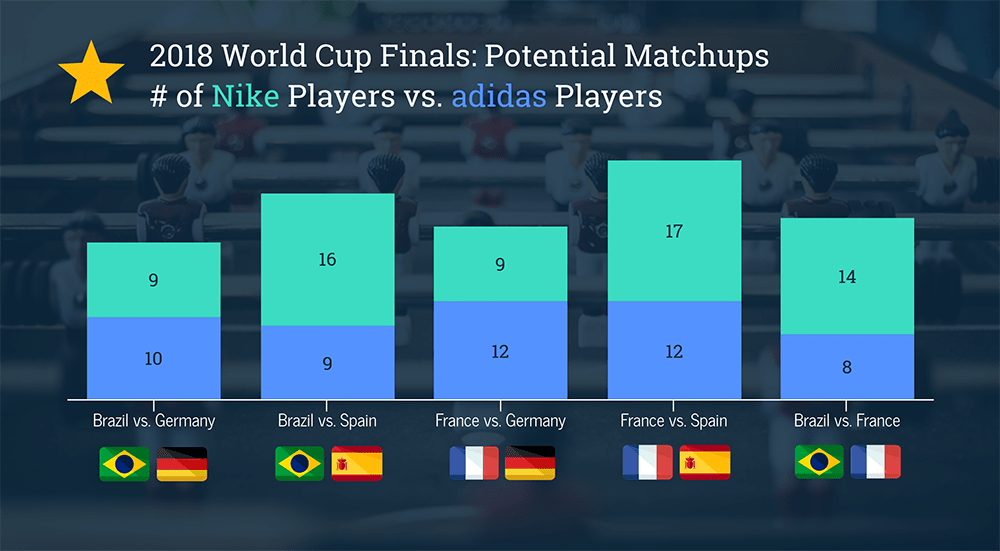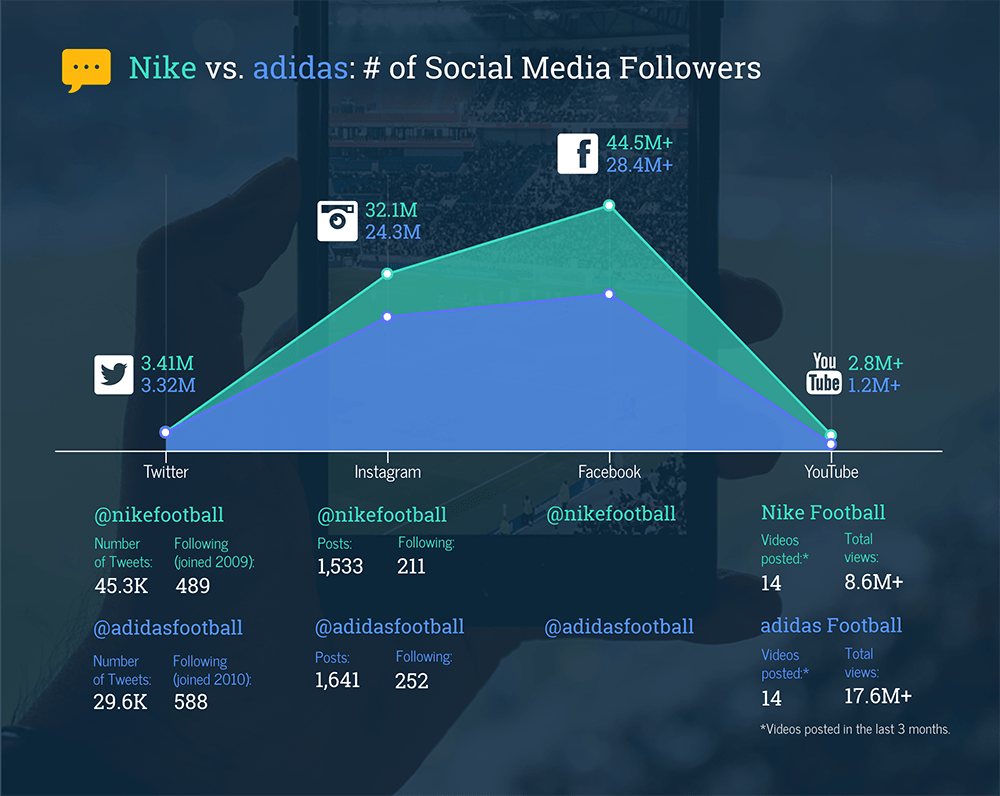
For many, the World Cup is a tournament between 32 national soccer teams competing to be the best on the planet.
For all the marketers out there, it has become an epic branding tournament between two of the world’s biggest sports-apparel brands: adidas and Nike.
Who do we think is going to win this year’s branding tournament? Check out this snappy overview of our analysis:
Surprised? Or was that the answer you expected all along?
Since 1970, when adidas became a FIFA partner and official sponsor to the World Cup, it has grown into a worldwide, undisputed soccer-apparel company. But for the last 20 years, Nike has attempted to change that. Nike has tried to replace adidas as the world’s leading brand for soccer gear worldwide.
Now, every World Cup, billions of people tune in as adidas and Nike sponsor national teams, sponsor world-class players, and execute their elaborate marketing plans…all in order to establish themselves as the best soccer-apparel company in the world.
Let’s take a closer look at how and why adidas is our 2018 World Cup of Branding favorite.
Learn more about branding:
On the road to the 2018 World Cup
During the 2014 World Cup, Nike really stood out. Its impressive marketing aside, it was also the first time Nike had sponsored more teams and players than adidas.
Still, that year was great for adidas:
- Two adidas teams went to the finals
- An adidas team won the cup
- An adidas-sponsored player won the Golden Ball
- An adidas-sponsored player won the Golden Boot.
- adidas saw record-breaking revenue and soccer-related sales.
In the months leading to the 2018 World Cup, both sports brands unleashed their creative campaigns. Provocative slogans and highly-distinctive color schemes set them apart, targeting specific audiences. Just take a look at the difference between these two promotional banners:

Adidas’ ‘Here to Create’ campaign

Nike’s ‘Fast by Nature’ campaign
Winning the World Cup is crucial for both brands. It would not only validate the company’s supremacy as the leading soccer-apparel brand, it would generate significant revenue and grow the business even more.
The World Cup is back and both brands are poised to take their marketing to new heights.
We’re here to predict who will win the 2018 World Cup of Branding.
First, let’s determine what winning really means for these two companies.
Defining the “win”
A big part of adidas and Nike’s brand strategy focuses on sponsoring teams and players that can win the actual tournament. That is a major achievement crucial to building their soccer-apparel brand.
But it’s not everything.
To really win the World Cup, it means one of the brands also saw more soccer-related revenue, developed more marketing buzz, and established a larger, more engaged following. All on top of winning the cup.
So how do we determine this year’s most likely winner? Well, we’ll look at data from the previous years, along with some predictions for this year and see who comes out on top.
The break down
We’re interested in who will win the cup, but also who’s going to get the biggest win for their marketing campaign and who’s going to generate more revenue.
With these considerations in mind, our analysis is broken down into five rounds.
Round One: Who is more effective at marketing?
This is a comparison of what each brand’s marketing expenditures look like and the revenue they have reportedly pulled in.
Round Two: Who has the best teams?
The best teams last the longest during the World Cup, which means more exposure for the brands that sponsor them. More visibility for a longer period of time helps the brand generate revenue. So who sponsors the most 2018 World Cup favorites?
Round Three: Who has the best underdog teams?
The thrill and excitement that an underdog generates can be capitalized on. This round determines which brand has the strongest underdogs.
Round Four: Who has more star players?
When world-class athletes endorse a brand, it drives revenue for that company. We’ll look at which teams will get furthest during the World Cup, to determine which players (adidas or Nike) will be visible for most of the tournament.
Round Five: Who has the strongest social media following?
Social media followings can tell us how the general public view adidas and Nike. Both of these brands have soccer-specific social media channels.
A winning brand strategy will see a higher online following and an engaged audience.
So now that the deciding factors are laid out, let’s dive into the numbers.
Round One: Who is more effective at marketing?
For every dollar spent on marketing, what are the returns that these two brands see during the World Cup?
We can’t be certain what each brand has decided to commit this year for its marketing costs.
In order to make a reasonable estimate, I looked at data from the 2014 World Cup, along with the current values of national kit deals from each brand.

adidasSource
adidas is an official partner of FIFA and sponsor of the World Cup. It costs adidas nearly $80M to be an official World Cup sponsor each year. That allows adidas to advertise within every stadium for every game; adidas is tasked with designing the Ball of the Match; adidas gets to outfit all FIFA personnel, referees, ball kids, volunteers and more with adidas gear.
In 2014, adidas is estimated to have spent more than $67m on advertising for the duration of the tournament. The actual figure was never disclosed.
This year, adidas has sponsored ten teams in the 2018 World Cup. Its most costly teams are:
Nike

Nike’s World Cup expenses are different, since it’s not an official sponsor of the tournament. It focuses almost exclusively on sponsoring winning teams and players.
For its marketing spend, Nike committed $876M leading up to the 2014 FIFA World Cup tournament. Aside from that, it also has its fair share of national teams that it sponsored.
These are Nike’s most expensive sponsorship deals for 2018:
So who’s better at marketing?
In terms of spending, adidas doesn’t commit the amount of funds that Nike does.
Based on the figures available, the cost of being an official sponsor, marketing expenses (if similar to 2014) and major kit deals could cost adidas close to $300M this year. If Nike markets itself as aggressively this year as it did in 2014, it will easily spend over $1bn on marketing and kit deals.
Comparing these figures, Nike’s cost to participate in the World Cup is nearly four times that of adidas. So who gets more bang for their buck?
In 2014, both brands established new personal records for revenue following the World Cup. adidas exceeded its own revenue projections and Nike saw significant jumps in revenue compared to the same time in 2013.
But adidas saw more soccer-related revenue than Nike following the 2014 World Cup. Then in the years that followed, Nike’s soccer-related revenue fell, while Adidas’ continued to grow.
adidas takes this round.
Round Two: Who has the best teams?
For the 2018 World Cup, adidas will sponsor just one more team than Nike.
But of the teams sponsored, only a few are real contenders for the 2018 World Cup. According to a World Cup prediction model by David Sumpter, the teams with the highest chances of taking the cup this year are Germany and Brazil at 4/1 and Spain and France at 6/1.
On that scale, adidas and Nike are evenly matched. Germany and Spain have been long-term adidas teams. Brazil has been a Nike team for 20 years now and it’s unlikely to change any time soon. France is a relatively new team for Nike, but perhaps it will be worth the cost.
Nike obtained its first sponsorship deal with France in 2011 for $50M a year, spending four times the amount that adidas had in previous years. The contract was extended from 2018 to 2026 for at a cost of $60M a year.
This even matchup between the two brands is a result of Nike’s continued aggressive investment in the European soccer market.
This round is a tie.
Round Three: Who has more underdog teams?
We know who the major contenders are for this year. But let’s dig a little further to see which teams might shake things up..
The World Cup has its share of surprises. Italy failed to qualify this year (too bad, Puma!). In 2014, Spain didn’t make it out of the first round and Brazil was absolutely humiliated. The underdog, Argentina, advanced to the finals instead.
Underdogs help drive revenue because they encourage more spending in unexpected places. Supporting the underdog at the right time has proven to be lucrative for some major brands.
In that case, adidas has far better picks than Nike (according to Sumpter’s bot).
Argentina has odds of 7/1 and Belgium 10/1, both adidas-sponsored teams.
Nike has less prominent opportunities to take the World Cup by storm when its only other top-tier teams, Portugal and England, have 20/1 odds to win it all.
Factoring in the few teams that could surprise us, adidas arguably sponsors the strongest contenders overall to win the cup or at least make a good run for it. Nike only sponsors two real favorites.
This round goes to adidas.
Round Four: Who has more star players?

Left to right (top): Mesut Ozil, Lionel Messi, David de Gea, Paul Pogba
Left to right (bottom): Cristiano Ronaldo, Eden Hazard, Neymar Jr., Harry Kane
Which brand has the most marketable players that could potentially make the finals?
It’s important to know that sponsoring a national team is very different from sponsoring an individual player.
Sponsoring a national team means sponsoring that organization. It allows the brand to design the team jerseys and incorporate their logo into that design.
The individual players can also be sponsored. Nike’s brand strategy from the start, especially when adidas sponsored a majority of the national European teams, has been to pursue individual players. Nike designed soccer cleats for the players to wear and built its soccer-apparel brand around the players’ performance.
We looked at a list of the 100 top-ranked players and found that Nike sponsors over half of them. But before we check the box and give this round to Nike, let’s look at how many of those players belong to the four 2018 World Cup favorites.
Here are the world’s top 100 players currently on for Germany, Brazil, France and Spain’s national teams:

Across all four teams, Nike sponsors a total of 23 players to adidas’ 22. While that’s a close match up, it falls to Nike.
If we include the star players on Argentina, Belgium, Portugal and England’s national teams, then Nike jumps ahead to 34 players with adidas lagging behind at 28. Nike has almost double the players to adidas’ additional six:
Matchups: Who will see more top-tier players in the finals?
Now, we also want to know if these brands have sponsored the right mix of players. When we consider some likely World Cup Finals matchups, we can determine which brand will see more of its stars drawing in the biggest crowds.
Using Telegraph’s World Cup 2018 predictor, and favoring our top picks (including the underdogs), we created a few different 2018 World Cup Finals matchups.
From examining the breakdown, and looking at some of the more likely finals matchups, Nike players will dominate the World Cup finals. There is even an opportunity for a Nike-only finals, if Brazil and France were to face one another.
This round goes to Nike.
Round Five: Who has the strongest social media following?
Both brands have involved themselves heavily in the World Cup. Their player sponsorships and long-term kit deals play a significant role in getting the upper hand in this branding tournament.
But what do their global audiences think about them? Taking a look at adidas and Nike’s social media accounts paints a clear picture.
At a glance, Nike seems to be ahead of adidas by leaps and bounds. But a real social-media following is one that’s genuinely engaged by the brand. So whose audience is more tuned in?
It’s clear that Nike leads the charge on Instagram and Facebook. Nike has about 8M more followers than adidas with roughly the same number of posts. While on Facebook, Nike has about 15M more followers than adidas.
On Twitter, Nike has slightly more followers, but has 15,000 more tweets and joined the platform a year before adidas.
adidas dominates YouTube with its soccer channel.
adidas has less than half the subscribers that Nike’s YouTube soccer channel has, and only a quarter of the overall views. But in the past three months leading up to the 2018 World Cup, adidas has received double the amount of views. adidas also averages 1.26M views per video, while Nike averages around 600K.
Similarly, adidas is half as active on Twitter compared to Nike, but has nearly the same number of followers.
For its efforts, adidas is the most visible brand on social media, receiving an average of 6.7M image-shares a month. This demonstrates adidas’ ability to engage a larger audience with high-quality content that is relevant to them.
This round goes to adidas.
The Golden Ball: Which brand has the world’s best player?

Before we wrap up our analysis, there is one more aspect of the World Cup worth looking at for its marketing potential.
The Golden Ball, commercially known as the adidas Golden Ball, was introduced into the World Cup by adidas and France Football in 1982. The Golden Ball is an award that recognizes a single player who performed exceptionally well and stood out during the entire World Cup.
This is a great example of how adidas has helped shape the World Cup a sporting event. And perhaps, this is also a look at how adidas can influence certain outcomes within the World Cup.
If a Nike team were to nab the World Cup this year, it would be a major branding victory. Even then, Nike’s stars could be overshadowed if an adidas player was recognized as the star of the entire event.
And that is pretty likely.
Let’s look at who won the Golden Ball in the last five World Cups.

Left to right: Ronaldo, Oliver Kahn, Zinedine Zidane, Diego Forlan, Lionel Messi
Looking at the previous winners in recent years, there is a trend.
We have a Nike-sponsored player win the Golden Ball in 1998. Ronaldo, makes his World Cup debut at the age of 22 and scores 4 goals to take Brazil to the finals that year.
Since then a Nike-sponsored player has never received the Golden Ball. In 2002 and 2006 both players were sponsored by adidas and on adidas teams.
In 2010, a Puma-sponsored player won the Golden Ball. Netherlands and Spain went to the finals, Netherlands a Nike-sponsored team and Spain sponsored by adidas. However, the game was decided by a single goal from Iniesta who was a Nike-sponsored player.
In 2014, the choice of Lionel Messi (adidas’ most valuable player) as the Golden Ball recipient was met with criticism. Some favored James Rodriguez as the Golden Ball winner due to his phenomenal performance that year as Colombia’s striker.
Even so, the young Rodriguez (also an Adidas-sponsored player) already won the Golden Boot as the top goal-scorer of the tournament.
We can ignore the notion that adidas influences the Golden Ball recipients. The trend over the last 5 World Cups tells us plenty on its own. Nike players are the least likely to win, and adidas players the most likely to win.
The Final Tally: Who is likely to win the 2018 World Cup of Branding?
Overall, adidas spends less than Nike on marketing and sponsoring teams in the World Cup. With less spending, adidas still sees higher revenues from soccer gear worldwide. Even in 2014, when Nike drove an impressive marketing campaign, adidas saw more sales following the World Cup.
Both brands sponsor World Cup favorites this year. So Nike and adidas can expect to have an equal shot at winning the cup itself.
When we don’t focus on the main World Cup contenders, adidas sponsors the underdogs that show the most promise. That means adidas has a higher chance to see more of its teams performing spectacularly for the duration of the 2018 World Cup.
However, Nike sponsors the majority of top players in the World Cup. There is a good chance that some of the most incredible plays in each game will be accompanied by the signature swoosh.
Lastly, adidas sees more engagement on social media. The content it produces draws a more committed following than Nike’s. This is important to distinguish because a loyal following will spend money on the brand, while a superficial one won’t.
That’s why we predict that the winner of the 2018 World Cup of Branding is…
adidas.
adidas can expect to take home the trophy, the glory, the profits, the social media following, the access to new markets and more.
Nike has done tremendously well to contest adidas’ reign in the world of European football, especially in a short span of 20 years. But as an official event sponsor, adidas has access to platforms and markets that Nike does not.
adidas creates more relevant content for an engaged, loyal, long-term fan-base. Also, due to its brand, adidas continues to see climbing revenue from soccer gear, as Nike’s declines.
So what do you think of this analysis? Is it finally Nike’s year to overtake adidas in the world of soccer? Or will adidas reign supreme once more in the world of soccer?
Share your thoughts!
More pop culture infographics:
Every Betrayal Ever in Game of Thrones [Infographic]
7 Essential Design Principles We Can Learn From Star Wars [Infographic]
What Disney Villains Can Tell Us About Color Psychology [Infographic]
Why You Shouldn’t Be Afraid of Serial Killers [Infographic]
We Looked At 429,702 Reviews To Find The Best Foodie City in America


































